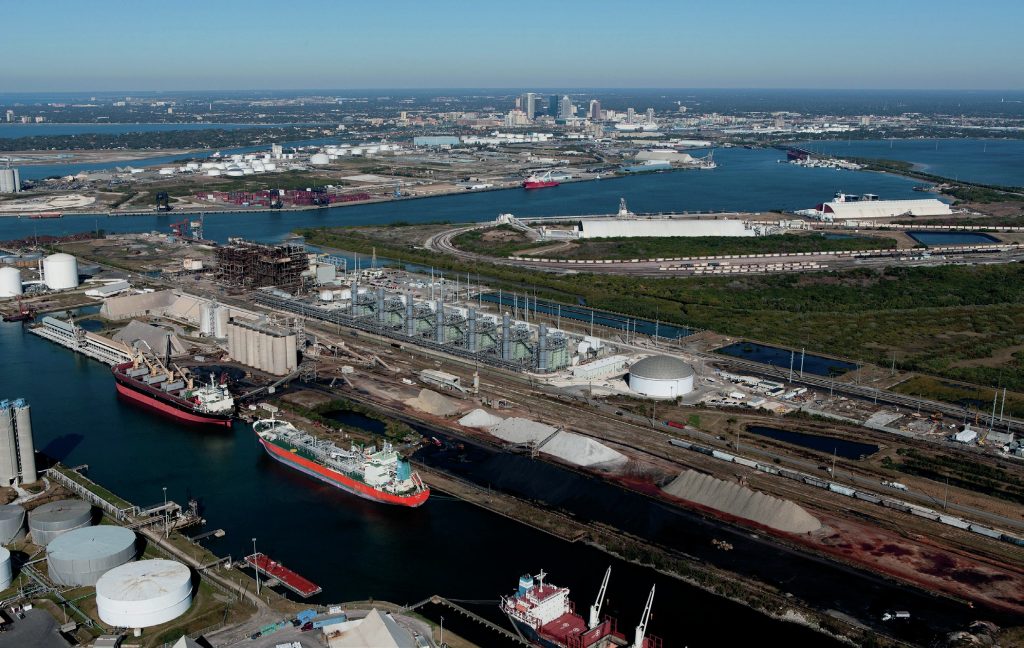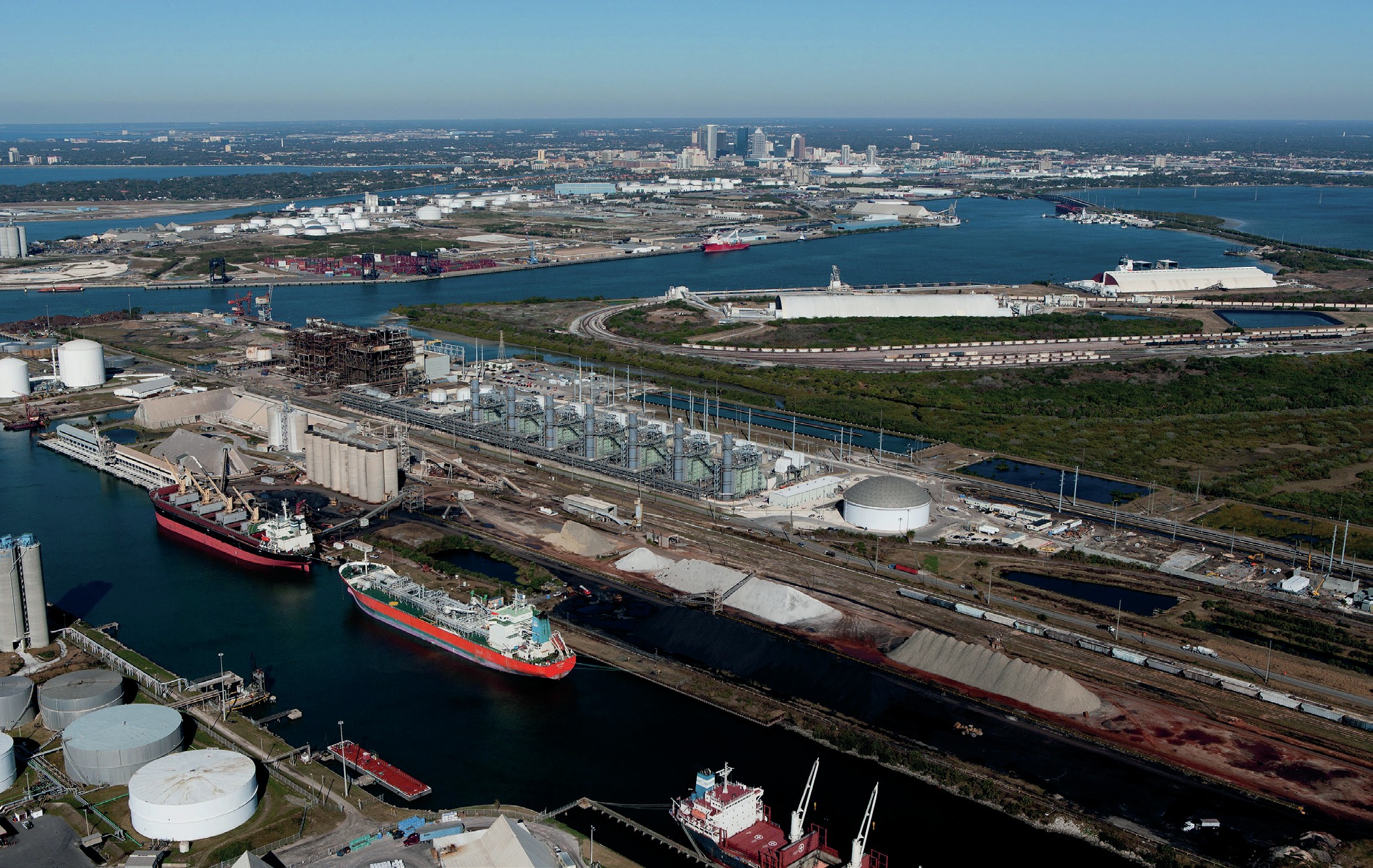Sulphur 401 Jul-Aug 2022

31 July 2022
Sulphur World Symposium 2022
CONFERENCE REPORT
Sulphur World Symposium 2022
The Sulphur Institute’s (TSI’s) annual Sulphur World Symposium was held in Tampa, Florida this year, from May 9th-11th.

After the cancellation of the 2020 Sulphur World Symposium due to the covid-19 outbreak and last year’s virtual conference, it was a welcome return to a face to face meeting for the 2022 event. Held at Tampa, one of the major ports for import of sulphur into the US, the Symposium began with a waterside tour of industry facilities in the Tampa Bay region, covering both liquid and dry bulk import and export terminals that support the sulphur, sulphuric acid, and fertilizer supply chains.
Global economic outlook
As is traditional the Symposium proper began the next morning with a roundup of the global economic outlook, this time presented by Dr. Georgy Egorov, professor of Managerial Economics & Decision Sciences at the Kellogg School of Management. He reviewed the disruptions of the past two years, with the covid outbreak leading to a major recession, driven by both demand and supply disruptions which were larger than expected. However, remote working, vaccines and major financial assistance programmes in developed countries have finally led to a rapid rebound in demand that supply chains have yet to catch up with. The Ukraine war on top of all of this has compounded supply issues and led to commodity prices spiking to levels not seen for more than a decade. There has also been an upswing in populism and anti-globalism and, Georgy argued, a distrust or antipathy to global institutions which have not been able to tackle the crises. Overall world economic growth is now forecast to drop from 6.1% in 2021 to 3.6% this year and next, with developed economies averaging 3.3% and 2.4% in 2022 and 2023, and emerging markets 3.8% this year and 4.4% next. Growth remains strongest in developing Asia, followed by sub-Saharan Africa. Georgy also pointed out that growth has returned in international trade in goods, but not services. High prices are fuelling inflation, and expectations of inflation, leading to tight money and a risk of recession in G20 countries. The outlook remains uncertain because of the Ukraine situation, with a real risk of a food crisis in the Middle East and energy crisis in Europe. Over the longer term, Georgy forecast a more fragmented world, with reshoring of companies and uncertainty over the future of the EU, WTO and China.
Dry bulk freight markets
Brian Malone of MID-SHIP Group looked at freight markets, all of which are at high values, though not as high as 3Q 2021. Year on year, the Baltic Index is up less than 2% for most ship classes, except for a 10% hike in Capesize markets. Freight rates are forecast to peak over the next three months before falling back from October onwards. There is a relatively fine balance between vessel supply and demand, but bullish sentiment in commodity and fuel markets, coupled with inflation and rising interest rates. High sulphur fuel oil is trading at a $110-180/t discount to low sulphur fuel oil, for those who are able to operate fuel scrubbers.
Global energy outlook
The global energy outlook was presented by Thomas Miller of BP Energy. He looked ahead at energy demand in 2050 according to three scenarios; New Momentum, representing the current broad trajectory of the global energy economy, including an increasing focus on decarbonisation; Accelerated; and Net Zero, which explore how different elements of the energy system might change in order to achieve a substantial reduction in carbon emissions. New Momentum would see a rise of 10-15% in global energy consumption out to 2050, Accelerated a reduction of a similar magnitude, but achieving Net Zero would take a 25% reduction in energy use over today. Even New Momentum would see a decrease in use of fossil fuel use of 25% by 2050 compared to today, however, with oil consumption dropping to 80 million bbl/d, with Net Zero a 75% fall. Gas demand would rise under New Momentum to 5 tcm per year, with power generation taking the largest slice of this, but fall sharply under the other two scenarios, which would require much greater investment in renewable energy. There followed a discussion on carbon credits led by Jeff Cole of Shell Emerging Energy Solutions.
Sulphur enhanced fertilizers
Dr Hunter Frame, an agronomist form Virginia Tech University, looked at sulphur’s role in the environment, especially as regards crop nutrition. Taking the whole of North America as his starting point, he pointed out that while reducing sulphur burning in fuels or scrubbing coal power station stack emissions has reduced sulphur deposition in the industrial mid-west, for much of the country little has changed. This has led to an increased consumption for sulphur containing fertilizers, particularly for sulphur hungry crops like peanuts and sugarcane. However, concerns about the effect of sulphate on soil health and leaching into water courses do not seem to be borne out by evidence. Indeed, soil sulphur levels appear to continue to fall. The behaviour of sulphate in the field can be difficult to model, as mineralisation rates are unpredictable, and sulphates can be held in deep clay layers and released slowly. Deep soil sampling can show surprisingly high sulphur levels, but this is not necessarily available to the plant.
Overall, he supported higher application rates for agricultural sulphur and greater use of sulphur enhanced fertilizers, pointing to the significant yield increases and benefits to plant health that it can bring.
Phosphate market
Mike Rahm, formerly of Mosaic but now operating his own consultancy, presented the phosphate market outlook. He noted how we seemed to have entered a ‘new normal’, where prices of many commodities were now 2-3 times what the average price had been during 2015-19. In the case of phosphates, he discounted the idea that US duties on phosphate imports had much to do with current price levels, but rather a series of fundamental factors including strong demand driven by higher agricultural commodity prices and the need to increase crop production; a muted supply response to the price fly-up and a thin pipeline of projects; major changes in Chinese industrial, environmental and export policies; elevated raw materials costs due partly to the rapid transition to low-carbon energy (particularly in Europe); and of course disruptions caused by the Russia-Ukraine war.
Tackling these factors one by one, he highlighted Brazilian import demand, which has tripled in the past decade, and continuing strong demand from India. There is a need for increased crop production, and global stocks of grain and oilseed are below their usual range bounds, driving up crop prices. Conversely, supply build is relatively muted; US phosphoric acid production has actually declined by 25% over the past decade, and while Moroccan exports have increased, Russian exports (prior to the war) and Chinese exports had been flat. Indeed, recent Chinese restrictions on phosphate exports have led to a 58% drop in supply from China. Meanwhile, prices of key inputs such as sulphur and ammonia (for MAP/DAP production) are at very high levels, and in ammonia’s case expected to remain so, increasing the base production cost of DAP by $450/t in two years. Ammonia availability could even limit Moroccan production this year, and Morocco has also historically sourced 10-20% of its sulphur requirements from Russia.
Overall, Mike expected phosphate process to remain higher for longer, absent any of three things; a resolution to the Ukraine conflict, an earlier than expected and larger return to the market for Chinese exports, or extreme demand destruction resulting from higher prices. Looking further forward, he saw a positive long-term outlook based on moderate demand growth, large capacity additions and higher operating rates. Requirements for renewable diesel fuel in the US could boost oilseed production and “do what ethanol did for corn fifteen years ago”. Other fresh demand might come from lithium ion phosphate batteries for electric vehicles and Chinese feed grain demand. However, he pointed to declining grades of phosphate rocks and falling sulphur production as the world switches away from fossil fuels as potential issues for phosphate production in the longer term.
Sulphur and sulphuric acid
CRU’s Peter Harrison ended the Symposium with the traditional round-up of sulphur and sulphuric acid markets. Sulphur prices were at a 14 year high, he said, though still below the record levels seen in 2008. The had begun rising in early 2021, driven by supply tightness and a rebound in demand, then run up further at the end of last year due to lower exports from the Middle East and Russia, before finally shooting up in 2Q 2022 because of the Ukraine conflict. Russia, Kazakhstan and Turkmenistan collectively represent 18% of the world’s 34 million t/a of traded elemental sulphur, but dependence on these sources is much higher in some regions; 34% in Europe and 50% in Brazil. Russian exports had already been falling prior to 2022, and though buyers are still taking Russian sulphur, sanctions have impacted trade.
Acid prices are also elevated, though the rate of increase has slowed. Sulphur price increases have outpaced rises in consuming markets such as copper, nickel and phosphates, leading to demand destruction, and sulphur consumption is likely to be down in 2022 by about 1.2 million t/a, particularly in China and the CIS, with a rebound next year in Africa and south and southeast Asia. However, Peter saw increased consumption out to 2026, mainly from phosphates in spite of a dip this year, but a significant proportion also coming from metals demand, particularly nickel. Supply growth will slow this year, though still overtake demand, but while a number of new projects will see major supply additions after that, mainly in the Middle East and Asia, demand growth may still outpace new supply out to 2026.






